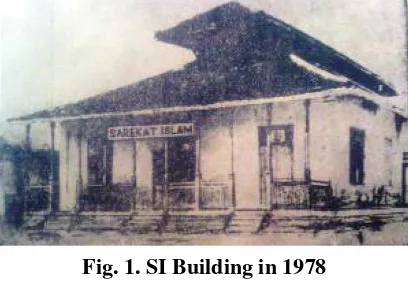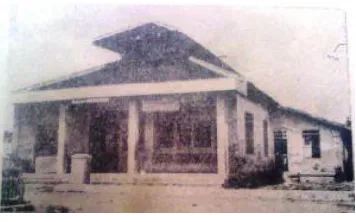“Empowering Partnerships and Understanding Social Impact in Heritage Management” 14 November 2015, Soegijapranata Catholic University, Semarang, Central Java, Indonesia
Study of Local Community’s Role in Restoring Gedung Sarekat
Islam
cultural heritage. In 2008 this building started to break down and would be torn down and rebuilt into a three-story commercial building. Komunitas Penggiat Sejarah (KPS) is a local community in Semarang which cares about the history and heritage, made a move and urged to the local city government to ban the building torn down and restore the building. Authors were interested in steps that KPS took and carried out so that eventually the building can stand as it has been remained before. This paper will tell how the efforts and activites that have been done by KPS so that a cultural heritage got the attention and be restored from the local city government. The spirit of the local community could be inspiring to the similar activities in the future. The method used to write this paper was to interview a heritage activist as well as to collect some photographs of documentation both before and after restoration SI Building.Keywords:Gedung Sarekat Islam, Komunitas Penggiat Sejarah.
Introduction
Heritage is historical evidence that can not be denied. The only form that can be watched and exposed a particular fact is the building itself. Hereditarily philosophical value of heritage will remain alive and be a source of reflection, especially if the evidence of the building can be still seen even explored. One of the heritage building established by the government is Gedung Rakyat Indonesia (GRI), known as Syarekat Islam Building (SI) named as the Center for Muslim now (Suara Merdeka, 2013). GRI building, built and established by the chairman of the SI, Mr. Samaoen in 1919-1920, has a similar architecture with to the Pekalongan railway station. It is because Mr. Samaoen was one of the member of Labour Union of Railways and Trams (Yunantyo, 2013).
Fig. 1. SI Building in 1978 Source: yunantyoadi.files.wordpress.com
This building has a full of historical value. Mr. Yunantyo Adi (interview dated October 17th 2015said that this building once was used for the pre-independence movementto a physical revolution “Pertempuran Lima Hari” in Semarang against Japanese troops. He said that the building also became the witness of Semarang people fighting against the Dutch and the British after Japan stripped the Allies as well. In the beginning of its establish, this building was ever used by SI, Budi Utomo, Indische Party, Vereeniging Spoor en Tremweg Personeel (VSTP), SI School, the Communist Party of Indonesia (PKI), Revolutionary Vaksentral, Sarekat Rakyat dan Chinese ethnicity. (Yunantyo, 2015).
We know that this building has a truly full of historical story, being a witness of the Indonesian people fight fo the independency. During those political movements, SI Building certainly spawned a number of prominent figures, including Mr. Samaoen, Mr. Darsono, Haji Boesro,HOS Tjokroaminoto, Haji Agus Salim, Alimin, Tan Malaka, Bergsma, Mr. Tjioto Manoenkoesoemo, Mr. Douwes Dekker, Ki Hajar Dewantara (KPS, 2015). Year by year, since the SI Building has been established, the control of the building moved to one hand to another hand. Interestingly the building has been standing still although was left dormant in 1979-2008.
Gedung Sarekat Islam
Fig. 2. SI Building facade after renovation in 1980s Source: www.yunantyoadi.files.wordpress.com/2013
It has an area of 1130m2 consisting 3 main rooms with a spacious one in the middle supported by 22 wooden pillars. There are two types of beams which support the building, a round-shaped pillar with a diameter of 20 cm supporting central part of the building consisting of two rows and each row consists of five line pillars. The distances between rows are 7.7m and 4m. Other types of columns that are square-shaped wooden pillars with a wide of 24cm. (Study of the Ministry of Culture, 2014).
Fig. 3. Si Building interior before renovation Source: kebudayaan.kemdikbud.go.id/2014
As in most colonial buildings in Indonesia, SI building has a tiered-roof made of wood. Among the existing arrangement, there are louvers made of wood as well. This roof has similar style which was
very popular in the early 20thcentury in Indonesia, similar to Pekalongan station building’s roof.
In 1965, there was a sentiment to PKI (Indonesian Communist Party), the riot against the PKI member happened in every city in Indonesia, in Semarang as well. Since this building was the
former school where Tan Malaka (the communist party’s figure) taught and used to be headquarter
of SOBSI (Indonesian Labors Organization) alliance by PKI, people who hated anything related PKI destroyed it.
Urgency of Restoring Gedung Sarekat Islam
In the interview dated October 17, 2015, Yunantyo told us that in 2008 the building was discovered by Rukardi Ahmadi, a journalist who Suara Merdeka. Then he told me about the history of the SI Building written in the newspaper where he works. However, for nearly five years there was neither response from historians nor the public. In 2010, with the help of Mrs. Rahayuningsih, headman of Sarirejo at the time, they reported that case to the city government in order to get attention from the
government. But they couldn’t get any approval still.
Fig. 5.SI Building condition before restoring Source: www.yunantyoadi.files.wordpress.com/2013
In 2012, Rukardi Ahmad, Adhitia Armitrianto (journalist Suara Merdeka) and Tjahjono Rahardjo (chairman of Sobokartti, House of Artist), members of the community history lovers, reported endangerment of historical buildings to the Archaeological Heritage Preservation Hall (BP3) to
news titled "Historic Buildings Threatened Torn Down" at Suara Merdeka on 6th September 2012.
But, a year later there was still no meaningful response from the BP3 and the Municipality of Semarang.
In the middle of April 2013, Yunantyo involved and began to make a complaint to the Mayor of Semarang at that time. Equipped with the data from book carried by fellow journalists, namely Pratono (journalist of Jawa Pos), they initiated what they brought to the Mayor. In the book Semarang (1956) written by Soekirno stated that a brief history about the building SI:
advocates who had used the building was Tan Malaka. Between 1926-1927 at the same time of arrest and deportation to Digul, the building was shut down. In 1930 the building was opened again by a committee consisting of PBI (Persatuan Bangsa Indonesia), Partindo, PNI (Indonesian National Party) and others for meetings. At the time the Japanese invaded, it was not used to nothing. In 1930-1938 it was visited by Bung Karno, Bung Hatta, Sjahrir, Sartono, AK Gani, Amir Syarifuddin, Muhammad Yamin, Woejaningrat, doctors Soetomo, etc. At time of proclamation of Indonesian independence, the building was unused. At the time of the battle Five Days in Semarang, it was used by Red Cross."
Yunantyo then create documents based on historical data in a more orderly and began to engage with the Institute for Preservation of Cultural Heritage (BPCB) and the City Government. Together with the new findings of the new data that was written by a history expert Dr Dewi Yuliati Undip titled "Nationalism History of Labor in Indonesia", as well as a small brochure "SI Semarang and Onderwijs" by Tan Malaka. Those book as well as the books "History of Semarang" and "Semarang" were photocopied by Yunantyo and then sent to BPCB Central Java. According to the Working Group of Publications BPCB Java Revelation, Kristianto, also the assessment team to the building's former SI offices, those data were very helpful and able to accelerate the review process. And then after assessment, it was founded that SI Building was one of the heritage buildings based on legal framework RI: Law No.11 of 2010 on Heritage, article 5 of Law Decree 11 of 2010 mentioned that the Objects of Cultural Heritage Buildings or Structures Heritage should meet the criteria:
a. Aged 50 (fifty) years or more
b. Represents the style of the age of 50 (fifty)
c. Has a special meaning for history, science, education, religion and / or culture
d. Has a cultural value for the strengthening national identity.
Based Article 5 of Law Decree 11 of 2010, the SI building had a heritage criteria: a. SI building was built in 1919, so that in 2013 was 94 years old.
b. The architecture of the building was characterized on the shape of the roof that required wide-span roofs such as that shown in SI building was very popular in the early 20th century.
c. Had a special meaning for history, that the SI Building witnessed the emergence of lower classes movement organizations in achieving independence.
d. Had a cultural value indicated by the spirit of cooperativeness (gotong-royong) unconditionally.
So that, on 27th February 2014, the Government established that Si building into a heritage building which was going to be assisted in financing the restoration. Finally, on September 2014 the restoration started and was completed in three months after.
Fig. 6.SI Building after restoring and its authentic “SI” black tile Source: kebudayaan.kemdikbud.go.id/2014
Komunitas Penggiat Sejarah (KPS): Local Community’s Role
History Activits Community (KPS) was established on August 10, 2013 as the reporting and filing the document file to government departments of cultural heritage. Community, chaired by Rukardi Ahmadi was initially called Community History Lovers. Its members consisted of journalists, legal activists, historians, academics and students. Some things that we could learn from the steps taken by KPS were:
1. Lobbying to related parties, such as local authorities, municipalities, provincial
governments, the owner of the building, as well as academics.
2. Searching for historical data written on the history of the SI Building, although it was difficult because the building SI was not much mentioned in many history books in Indonesia.
3. Seeking support from various communities, such as Lopen Community (Historical and
Heritage Concerned Community), Kota Lama Community, Bike Community, as well as other youth-people communities.
4. Mobilising public attention through the media by writing articles in the media concerning
the history and SI Building urgency that were part of the history of the people’s struggle of
Semarang.
5. Conducting activities that attracted the attention of the mass medias: tumpengan, watch a movie together in the building SI. What had been done might be similar to what people had done in the early years of building SI Building. They had donated property for the sake of building SI Building. Committee members also do donation for the implementation of activities that attracted the attention of the masses and the mass media.
6. Creating a movement to mobilize support netizen: making a petition at change.org so that
7. The hardest thing was to keep the SI Building always stood remain there and visited by many people: youth who cared and knew to be one of the building's history Semarang. The struggling for maintaining the SI Building itself was not completed until 2014. The struggle was not about politics or independecy anymore, it was all about the struggle to make the SI Building an icon of the historical building and cultural heritage as well. The polemic that KPS felt was so thick and complicated. Changing the abandoned building into a heritage was not as easy as falling of a log. Yuniatyo Adi, assited by some fellows, continued to fight for the exitence of SI Building through a very long way. It is interesting to study how they have fought for and how they eventually succeded to bring the almost-torn-down building into a historically heritage building.
References
Adi, Yunantyo. 2015. Interview “Perjuangan Komunitas Penggiat Sejarah” on SI Building, Jalan
Gendong Selatan 1144 Semarang
Harsoyo, Agus. 2015. Interview “Gedung Sarekat Islam” on SI Building, Jalan Gendong Selatan
1144 Semarang
Pratono.2015. Interview “Terbentuknya Komunitas Penggiat Sejarah” on SI Building, Jalan
Gendong Selatan 1144 Semarang
http://berita.suaramerdeka.com/blogjurnalis/sejarahdanposisihukumgrisarekatislam/ https://www.facebook.com/pages/Gedung-Sarekat-Islam-Semarang/1413144045648711 http://historia.id/modern/gedungsarekatislammakinterbengkalai



